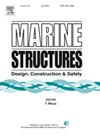On the use of an advanced Kirchhoff rod model to study mooring lines
IF 5.1
2区 工程技术
Q1 ENGINEERING, CIVIL
引用次数: 0
Abstract
In this work, we investigate the application of an advanced nonlinear torsion- and shear-free Kirchhoff rod model, enhanced with a penalty-based barrier function (to simulate the seabed contact), intended for studying the static and dynamic behavior of mooring lines. The formulation incorporates conservative and non-conservative external loads, including those coming from the surrounding flow (added mass, tangential drag, and normal drag). To illustrate the favorable features of this model, we consider some key scenarios such as static configurations, pulsating force applications at the fairlead, and fluid–structure interaction between mooring lines and the surrounding flow. Verification against well-established solutions, including catenary configurations and OpenFAST simulations, shows excellent accuracy in predicting mooring line responses for a floating offshore wind turbine. Among the most important results, we can mention that under normal pulsating loads at the fairlead, the mooring line exhibits a transition from a drag-dominated regime at low frequencies to an added-mass-dominated regime at higher frequencies. Furthermore, tangential forcing at the fairlead reveals a strong coupling between axial and bending dynamics, contrasting with normal forcing scenarios where axial dynamics remain largely unaffected. These findings underscore the potential of the proposed approach for advanced mooring line simulations.
利用先进的基尔霍夫杆模型研究系泊线
在这项工作中,我们研究了一种先进的非线性无扭转和无剪切Kirchhoff杆模型的应用,该模型增强了基于惩罚的屏障函数(模拟海底接触),旨在研究系泊线的静态和动态行为。该配方结合了保守和非保守的外部负载,包括来自周围流动的负载(附加质量、切向阻力和法向阻力)。为了说明该模型的优点,我们考虑了一些关键场景,如静态配置、导缆处的脉动力作用以及系泊线与周围水流之间的流固耦合作用。对现有解决方案(包括悬链线配置和OpenFAST模拟)的验证表明,在预测浮式海上风力涡轮机系泊线响应方面具有很高的准确性。在最重要的结果中,我们可以提到,在导缆处的正常脉动载荷下,系泊线表现出从低频时的阻力主导状态到高频时的附加质量主导状态的转变。此外,导叶处的切向力揭示了轴向动力和弯曲动力之间的强耦合,与轴向动力基本不受影响的正常强迫情况形成对比。这些发现强调了所提出的方法在高级系泊线模拟中的潜力。
本文章由计算机程序翻译,如有差异,请以英文原文为准。
求助全文
约1分钟内获得全文
求助全文
来源期刊

Marine Structures
工程技术-工程:海洋
CiteScore
8.70
自引率
7.70%
发文量
157
审稿时长
6.4 months
期刊介绍:
This journal aims to provide a medium for presentation and discussion of the latest developments in research, design, fabrication and in-service experience relating to marine structures, i.e., all structures of steel, concrete, light alloy or composite construction having an interface with the sea, including ships, fixed and mobile offshore platforms, submarine and submersibles, pipelines, subsea systems for shallow and deep ocean operations and coastal structures such as piers.
 求助内容:
求助内容: 应助结果提醒方式:
应助结果提醒方式:


